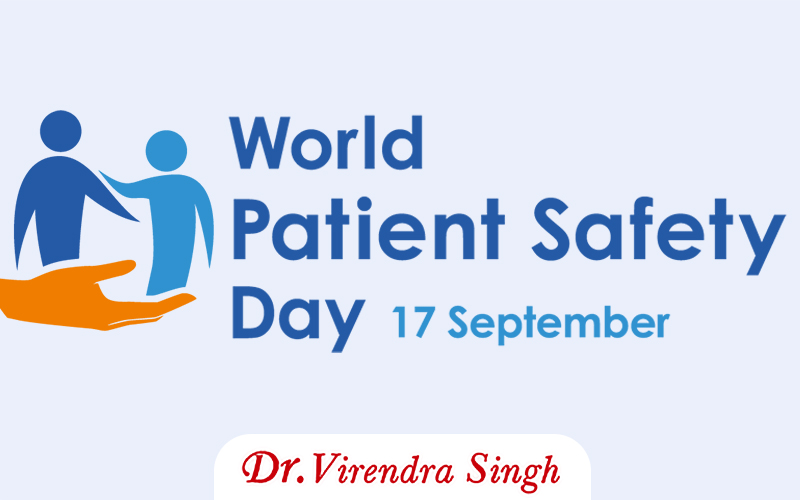
Every year on September 17, a global platform is provided to emphasize the vital importance of patient safety in healthcare systems across the globe. This yearly event seeks to eliminate preventable mistakes and harmful behaviors in healthcare settings by bringing attention to patient safety and inspiring nations to prioritize it. The World Health Organization runs 11 significant international public health initiatives, World Patient Safety Day being one of them. It is essential that the parties providing healthcare services have the necessary knowledge and expertise to handle patients with care and actively engage with them. Patient safety can be compromised in an array of ways, but drug errors have emerged as a major threat to preventing preventable harm in healthcare around the world.
On World Patient Safety Day 2024, Dr. Virendra Singh, a renowned healthcare expert, emphasizes the critical importance of patient safety in every medical setting. He promotes a patient-centered approach, emphasizing that safety is a shared duty of healthcare practitioners, patients, and policymakers. He emphasizes that i to reduce medical errors and guarantee high-quality care, it is imperative to establish advanced safety standards, maintain open lines of communication, and provide ongoing training.
Dr. Virendra Singh believes that empowering patients through education and fostering a culture of safety within healthcare institutions are key to achieving the global goal of safer healthcare for all. His guidance on this day serves as a wake-up call for global healthcare systems to put safety first and create a future in which patients may have faith in the treatment they get.
The Theme For World Patient Safety Day 2024
The Theme for World Patient Safety Day 2024 is “Improving diagnosis for patient safety” with the slogan “Get it right, make it safe”.
The History of World Patient Safety Day
In May 2019, the World Health Assembly adopted a resolution calling for international action on patient safety, which led to the creation of World Patient Safety Day. The yearly Global Ministerial Summits on Patient Safety, which were started in 2016 and were fueled by strong worldwide stakeholder commitment and advocacy, gave rise to this effort.
Objectives of World Patient Safety Day
- Raising Global Awareness
Raising awareness across the globe regarding the active involvement of patients, their families, and caregivers at all healthcare levels is the main goal. Such engagement is recognized as a potent means to significantly enhance patient safety.
- Engaging Stakeholders
On World Patient Safety Day, a variety of stakeholders are encouraged to take an active role, including legislators, executives in the healthcare industry, medical professionals, patient organizations, members of the public society, and more. The goal of these group initiatives is to improve patient safety procedures and regulations throughout the whole healthcare system.
- Empowering Patients and Families
Encouraging patients and their families to participate actively in their healthcare is a basic objective. Engaged and knowledgeable patients can significantly enhance healthcare safety by actively contributing to their own treatment and decision-making.
- Advocating Urgent Action
Proposals for prompt action in the areas of patient and family interaction are in line with the 2021–2030 Global Patient Safety Action Plan. The objective is to inspire all partners to take prompt and concerted steps toward advancing patient safety.
Facts on World Patient Safety Day and Medication Harm to Patients
- One in twenty individuals receiving medical care may experience medication-related side effects that may have been prevented, and one in four patients may experience illnesses that could be fatal.
- Medication harm is the leading cause of avoidable harm, it accounts for nearly 50% of overall avoidable harm in medical care.
- Elderly patients had the highest rate of pharmaceutical harm, followed by those in intensive care units and emergency departments.
- Medication errors can happen while prescribing, administering, and monitoring medicines to patients.
- Medication harm can be reduced and prevented by hiring qualified healthcare professionals who are knowledgeable about prescription, administration, and monitoring protocols; by ensuring that the clinical team works together effectively; and by teaching patients about the potential side effects of their medications and how to take them.
17th September 2024 Special Day
Healthcare professionals are looking forward to September 17th, World Patient Safety Day, and the opportunity it presents to realign attention toward this crucial problem. This year’s celebration is a wonderful chance to aim high in the field of medicine, redesign processes to remove unnecessary hazards, and maintain the belief that the needs of patients come first. The approaching World Patient Safety Day in 2024 inspires optimism for a bright year to come and a future in which international forums will continue to emphasize the vital significance of patient-centered care. This special day raises awareness around eliminating unsafe practices and motivates nations so safe healthcare becomes our shared reality.
FAQs
What is World Patient Safety Day?
Every year on September 17, the world observes World Patient Safety Day to bring attention to patient safety concerns and encourage action to enhance systemic safety. It is led by the World Health Organization (WHO) and attempts to improve patient safety while raising the standard of treatment globally.
What is the Theme for World Patient Safety Day 2024?
The Theme for World Patient Safety Day 2024 is “Improving diagnosis for patient safety” with the slogan “Get it right, make it safe”.
Why is World Patient Safety Day important?
This day is important because patient safety is a critical issue in healthcare. Every year, millions of individuals throughout the world suffer avoidable injuries while receiving medical care. World Patient Safety Day raises awareness and motivates legislators, patients, and healthcare professionals to work together on policies that lower risks, enhance patient care, and guarantee a safer healthcare setting.
What are some common patient safety concerns in healthcare?
Medication mistakes, hospital-acquired infections, surgical problems, incorrect communication between medical staff, and diagnostic errors are among the common patient safety concerns. These can be reduced through careful planning, proper training, and the use of technology such as electronic health records.
What are some examples of patient safety improvements in healthcare?
Some examples include standardizing surgical checklists to prevent errors, minimizing hospital-acquired infections through infection control protocols, reducing medication errors through electronic prescribing, and enhancing team communication to ensure accurate patient information is shared.
